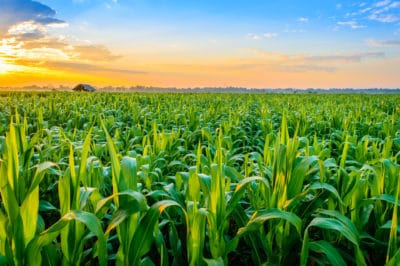Provide Plenty of Sunshine
One of the most important things to do if you are growing corn plants is to make sure they have access to plenty of sun. Whether you are growing an early-ripening sweet corn variety or a roasting ear variety, you need to plant your corn seeds in an area that gets a bare minimum of six hours a day of direct sun.
Tip: Like most sun-loving plants, corn thrives on lots of light. For a better harvest and healthier plants, 8-12 hours of direct sun is best.
Fertilize Regularly
Knowing how and when to fertilize your corn plants is just as essential to plant health as sunlight. It is important to understand that corn is considered a “heavy feeder.” Simply put, this means that the corn plants require a lot of nutrition, specifically nitrogen, to obtain an optimal harvest.
As a general rule, you should plan on fertilizing your corn three times throughout the season. The first application of good organic fertilizer should have occurred before planting. Once your corn plants begin to grow, you need to fertilize twice more; once when the corn plants are about 6 inches (15 cm) tall, then again when the corn tassels start to form.
Before planting, a general fertilizer containing nitrogen, phosphorous and potassium at a 16-16-8 ratio is adequate to allow your corn plants a good start. The second two applications of fertilizer should be nitrogen only unless you have tested your soil and find it lacking in other nutrients.
Tip: Remember that corn seedlings are somewhat delicate in the beginning. Use a side-dressing method to apply fertilizer, so you do not burn the corn leaves.
Water, Water, Water
Although being told to water your garden may seem unnecessary, you may need to water your corn more frequently than you do other plants in your plot. For one thing, corn plants have one deep taproot surrounded by a shallow network of roots that help stabilize the corn stalk. For these roots to get all the water they need for proper growth, you need to make sure you water frequently.
Additionally, although corn plants grow all over the world, they are best suited to hot, somewhat humid regions. To replicate this growing medium as closely as possible, water the corn plants at least weekly and often every three or four days.
Tip: Use a soaker hose or a sprinkler that is low to the ground. Not only does this allow water to reach the roots directly, it also conserves water by avoiding evaporation.
Weed Control
Once your corn plants reach about knee-high, weeds are naturally controlled because the sun cannot reach them through the corn stalks. However, before they grow high enough, weeds can quickly overtake the young corn plants.
To prevent as many weeds as possible, cover the corn rows with a thick layer of organic compost. A layer of two or three inches (5-7 cm) helps suffocate the weeds, preventing them from sprouting. However, heavy mulching will not eradicate all of the Many garden pests are. Using a hoe or by pulling by hand, get rid of weeds as soon as you see them emerge.
Pest and Disease Control
Pest Control
Although weeds are a detriment to corn plants, an even more significant enemy to your crop is pests and diseases. Many garden pests are attracted to corn plants, including:
- Corn Rootworm
- Southwestern Corn Borer
- European Corn Borer
- Corn Sap Beetle
Most pests you will find on corn can be controlled or eradicated by applying an organic insecticide to the entire crop.
Disease Control
Corn plants are susceptible to several different diseases, like leaf blight and stalk rot. Fortunately, you can treat most of these conditions with an organic fungicide. The earlier you identify the disease, the sooner you can treat it, so watch your corn crop carefully through all the growing stages.
Once you know how to treat your diseased corn plant, you also need to know how to prevent it. First, do not allow diseased stalks to compost; instead, burn any plant refuse to kill the disease. You should also rotate your corn crop from year to year, and also be sure the soil has adequate drainage. Doing so will help prevent disease, which is much easier than treating it!
Keeping Corn Plants Healthy Increases Yield
Although it may seem as if growing corn is more trouble than it is worth, the opposite is true. By providing an excellent growing medium and keeping your corn plants as healthy as possible, you increase the chances of having a bountiful harvest. Biting into your first ears of corn will make the work worth it!
